Dosing & Uses
Dosage Forms & Strengths
tablet
- 200mg
Parkinson Disease
200 mg PO with each dose of levodopa/carbidopa
Not to exceed 1600 mg/day
See also combo with levodopa/carbidopa
Renal Impairment
Dose adjustment not necessary
Hepatic Impairment
Safety and efficacy not established
Not recommended
Parkinson disease
200 mg PO with each dose of levodopa/carbidopa
Not to exceed 1600 mg/day
See also combo with levodopa/carbidopa
Interactions
Interaction Checker
No Results

Contraindicated
Serious - Use Alternative
Significant - Monitor Closely
Minor

Contraindicated (4)
- isocarboxazid
entacapone, isocarboxazid. Either increases effects of the other by pharmacodynamic synergism. Contraindicated. Both nonselective MAO inhibitors and entacapone inhibit catecholamine metabolism, leading to increased levels of catecholamines. Potential for dangerously high HR or BP.
- lonafarnib
entacapone will increase the level or effect of lonafarnib by affecting hepatic/intestinal enzyme CYP3A4 metabolism. Contraindicated. Lonafarnib is a sensitive CYP3A4 substrate. Coadministration with strong or moderate CYP3A4 inhibitors is contraindicated.
- phenelzine
entacapone, phenelzine. Either increases effects of the other by pharmacodynamic synergism. Contraindicated. Both nonselective MAO inhibitors and entacapone inhibit catecholamine metabolism, leading to increased levels of catecholamines. Potential for dangerously high HR or BP.
- tranylcypromine
entacapone, tranylcypromine. Either increases effects of the other by pharmacodynamic synergism. Contraindicated. Both nonselective MAO inhibitors and entacapone inhibit catecholamine metabolism, leading to increased levels of catecholamines. Potential for dangerously high HR or BP.
Serious - Use Alternative (11)
- elacestrant
entacapone will increase the level or effect of elacestrant by affecting hepatic/intestinal enzyme CYP3A4 metabolism. Avoid or Use Alternate Drug.
- infigratinib (DSC)
entacapone will increase the level or effect of infigratinib (DSC) by affecting hepatic/intestinal enzyme CYP3A4 metabolism. Avoid or Use Alternate Drug.
- lurbinectedin
entacapone will increase the level or effect of lurbinectedin by affecting hepatic/intestinal enzyme CYP3A4 metabolism. Avoid or Use Alternate Drug.
- metoclopramide intranasal
entacapone, metoclopramide intranasal. Either increases effects of the other by Other (see comment). Avoid or Use Alternate Drug. Comment: Avoid use of metoclopramide intranasal or interacting drug, depending on importance of drug to patient.
- nirogacestat
entacapone will increase the level or effect of nirogacestat by affecting hepatic/intestinal enzyme CYP3A4 metabolism. Avoid or Use Alternate Drug.
- olopatadine intranasal
entacapone and olopatadine intranasal both increase sedation. Avoid or Use Alternate Drug. Coadministration increases risk of CNS depression, which can lead to additive impairment of psychomotor performance and cause daytime impairment.
- omaveloxolone
entacapone will increase the level or effect of omaveloxolone by affecting hepatic/intestinal enzyme CYP3A4 metabolism. Avoid or Use Alternate Drug. If unavoidable, reduce omaveloxolone dose to 100 mg/day. Closely monitor for adverse effects. If adverse effects emerge, further reduce to 50 mg/day.
- pacritinib
entacapone will increase the level or effect of pacritinib by affecting hepatic/intestinal enzyme CYP3A4 metabolism. Avoid or Use Alternate Drug.
- repotrectinib
entacapone will increase the level or effect of repotrectinib by affecting hepatic/intestinal enzyme CYP3A4 metabolism. Avoid or Use Alternate Drug. Discontinue strong or moderate CYP3A inhibitors and wait 3-5 elimination half-lives before initiating repotrectinib.
- ropeginterferon alfa 2b
ropeginterferon alfa 2b and entacapone both increase Other (see comment). Avoid or Use Alternate Drug. Narcotics, hypnotics or sedatives can produce additive neuropsychiatric side effects. Avoid use and monitor patients receiving the combination for effects of excessive CNS toxicity.
- zuranolone
entacapone, zuranolone. Either increases effects of the other by pharmacodynamic synergism. Avoid or Use Alternate Drug. Coadministration of zuranolone with other CNS depressants may increase impairment of psychomotor performance or CNS depressant effects. If unavoidable, consider dose reduction. .
Monitor Closely (53)
- acrivastine
acrivastine and entacapone both increase sedation. Use Caution/Monitor.
- amisulpride
amisulpride and entacapone both increase sedation. Use Caution/Monitor.
- asenapine
asenapine and entacapone both increase sedation. Use Caution/Monitor.
- asenapine transdermal
asenapine transdermal and entacapone both increase sedation. Use Caution/Monitor.
- atogepant
entacapone will increase the level or effect of atogepant by affecting hepatic/intestinal enzyme CYP3A4 metabolism. Use Caution/Monitor.
- avapritinib
avapritinib and entacapone both increase sedation. Use Caution/Monitor.
- benzhydrocodone/acetaminophen
benzhydrocodone/acetaminophen and entacapone both increase sedation. Use Caution/Monitor.
- brexpiprazole
brexpiprazole and entacapone both increase sedation. Use Caution/Monitor.
- brimonidine
brimonidine and entacapone both increase sedation. Use Caution/Monitor.
- brivaracetam
brivaracetam and entacapone both increase sedation. Use Caution/Monitor.
- buprenorphine subdermal implant
buprenorphine subdermal implant and entacapone both increase sedation. Use Caution/Monitor.
- buprenorphine transdermal
buprenorphine transdermal and entacapone both increase sedation. Use Caution/Monitor.
- buprenorphine, long-acting injection
buprenorphine, long-acting injection and entacapone both increase sedation. Use Caution/Monitor.
- capivasertib
entacapone will increase the level or effect of capivasertib by affecting hepatic/intestinal enzyme CYP3A4 metabolism. Modify Therapy/Monitor Closely. Reduce capivasertib dose if coadministered with moderate CYP3A inhibitors.
- cariprazine
cariprazine and entacapone both increase sedation. Use Caution/Monitor.
- daridorexant
entacapone will increase the level or effect of daridorexant by affecting hepatic/intestinal enzyme CYP3A4 metabolism. Modify Therapy/Monitor Closely. Daridorexant dose should not exceed 25 mg per night when coadministered with moderate CYP3A4 inhibitors.
entacapone and daridorexant both increase sedation. Modify Therapy/Monitor Closely. Coadministration increases risk of CNS depression, which can lead to additive impairment of psychomotor performance and cause daytime impairment. - desloratadine
desloratadine and entacapone both increase sedation. Use Caution/Monitor.
- diazepam buccal
diazepam buccal and entacapone both increase sedation. Use Caution/Monitor.
- diazepam intranasal
diazepam intranasal and entacapone both increase sedation. Use Caution/Monitor.
- difelikefalin
difelikefalin and entacapone both increase sedation. Use Caution/Monitor.
- dobutamine
entacapone will increase the level or effect of dobutamine by decreasing metabolism. Use Caution/Monitor. Entacapone is a COMT inhibitor. Caution if coadministered with drugs metabolized by COMT. If coadministered, monitor for changes in heart rate, heart rhythm, and blood pressure.
- dopamine
entacapone will increase the level or effect of dopamine by decreasing metabolism. Use Caution/Monitor. Entacapone is a COMT inhibitor. Caution if coadministered with drugs metabolized by COMT. If coadministered, monitor for changes in heart rate, heart rhythm, and blood pressure.
- epinephrine
entacapone will increase the level or effect of epinephrine by decreasing metabolism. Use Caution/Monitor. Entacapone is a COMT inhibitor. Caution if coadministered with drugs metabolized by COMT. If coadministered, monitor for changes in heart rate, heart rhythm, and blood pressure.
- epinephrine inhaled
entacapone will increase the level or effect of epinephrine inhaled by decreasing metabolism. Use Caution/Monitor. Entacapone is a COMT inhibitor. Caution if coadministered with drugs metabolized by COMT. If coadministered, monitor for changes in heart rate, heart rhythm, and blood pressure.
- epinephrine racemic
entacapone will increase the level or effect of epinephrine racemic by decreasing metabolism. Use Caution/Monitor. Entacapone is a COMT inhibitor. Caution if coadministered with drugs metabolized by COMT. If coadministered, monitor for changes in heart rate, heart rhythm, and blood pressure.
- fentanyl
fentanyl and entacapone both increase sedation. Use Caution/Monitor.
- fentanyl intranasal
fentanyl intranasal and entacapone both increase sedation. Use Caution/Monitor.
- fentanyl iontophoretic transdermal system
fentanyl iontophoretic transdermal system and entacapone both increase sedation. Use Caution/Monitor.
- fentanyl transdermal
fentanyl transdermal and entacapone both increase sedation. Use Caution/Monitor.
- fentanyl transmucosal
fentanyl transmucosal and entacapone both increase sedation. Use Caution/Monitor.
- finerenone
entacapone will increase the level or effect of finerenone by affecting hepatic enzyme CYP2E1 metabolism. Modify Therapy/Monitor Closely. Monitor serum potassium during initiation and dosage adjustment of either finererone or moderate CYP3A4 inhibitors. Adjust finererone dosage as needed.
entacapone will increase the level or effect of finerenone by affecting hepatic/intestinal enzyme CYP3A4 metabolism. Modify Therapy/Monitor Closely. Monitor serum potassium during initiation and dosage adjustment of either finererone or weak CYP3A4 inhibitors. Adjust finererone dosage as needed. - ganaxolone
entacapone and ganaxolone both increase sedation. Use Caution/Monitor.
- gepirone
entacapone will increase the level or effect of gepirone by affecting hepatic/intestinal enzyme CYP3A4 metabolism. Modify Therapy/Monitor Closely. Reduce gepirone dose by 50% when used concomitantly with a moderate CYP3A4 inhibitor.
- isavuconazonium sulfate
entacapone will increase the level or effect of isavuconazonium sulfate by affecting hepatic/intestinal enzyme CYP3A4 metabolism. Use Caution/Monitor.
- isoproterenol
entacapone will increase the level or effect of isoproterenol by decreasing metabolism. Use Caution/Monitor. Entacapone is a COMT inhibitor. Caution if coadministered with drugs metabolized by COMT. If coadministered, monitor for changes in heart rate, heart rhythm, and blood pressure.
- lefamulin
entacapone will increase the level or effect of lefamulin by affecting hepatic/intestinal enzyme CYP3A4 metabolism. Use Caution/Monitor. Monitor for adverse effects if lefamulin is coadministered with moderate CYP3A inhibitors.
- levetiracetam
levetiracetam and entacapone both increase sedation. Use Caution/Monitor.
- levocetirizine
levocetirizine and entacapone both increase sedation. Use Caution/Monitor.
- loratadine
loratadine and entacapone both increase sedation. Use Caution/Monitor.
- lumateperone
entacapone will increase the level or effect of lumateperone by affecting hepatic/intestinal enzyme CYP3A4 metabolism. Modify Therapy/Monitor Closely. Reduce lumateperone dose to 21 mg/day if coadministered with moderate CYP3A4 inhibitors.
lumateperone and entacapone both increase sedation. Use Caution/Monitor. - mavacamten
entacapone will increase the level or effect of mavacamten by affecting hepatic enzyme CYP2C19 metabolism. Modify Therapy/Monitor Closely. Inititiation of weak CYP2C19 inhibitors may require decreased mavacamten dose.
entacapone will increase the level or effect of mavacamten by affecting hepatic/intestinal enzyme CYP3A4 metabolism. Modify Therapy/Monitor Closely. Inititiation of moderate CYP3A4 inhibitors may require decreased mavacamten dose. - mavorixafor
entacapone will increase the level or effect of mavorixafor by affecting hepatic/intestinal enzyme CYP3A4 metabolism. Modify Therapy/Monitor Closely. Monitor for mavorixafor adverse effects if coadministered with a moderate CYP3A4 inhibitor. If necessary, reduce mavorixafor daily dose.
- methohexital
methohexital and entacapone both increase sedation. Use Caution/Monitor.
- methyldopa
entacapone will increase the level or effect of methyldopa by decreasing metabolism. Use Caution/Monitor. Entacapone is a COMT inhibitor. Caution if coadministered with drugs metabolized by COMT. If coadministered, monitor for changes in heart rate, heart rhythm, and blood pressure.
- norepinephrine
entacapone will increase the level or effect of norepinephrine by decreasing metabolism. Use Caution/Monitor. Entacapone is a COMT inhibitor. Caution if coadministered with drugs metabolized by COMT. If coadministered, monitor for changes in heart rate, heart rhythm, and blood pressure.
- norgestrel
entacapone will increase the level or effect of norgestrel by affecting hepatic/intestinal enzyme CYP3A4 metabolism. Use Caution/Monitor. Strong or moderate CYP3A4 inhibitors may increase systemic concentration of norgestrel, which may increase risk for adverse effects
- oliceridine
entacapone will increase the level or effect of oliceridine by affecting hepatic/intestinal enzyme CYP3A4 metabolism. Modify Therapy/Monitor Closely. If concomitant use is necessary, may require less frequent oliceridine dosing. Closely monitor for respiratory depression and sedation and titrate subsequent doses accordingly. If inhibitor is discontinued, consider increase oliceridine dosage until stable drug effects are achieved. Monitor for signs of opioid withdrawal.
- palovarotene
entacapone will increase the level or effect of palovarotene by affecting hepatic/intestinal enzyme CYP3A4 metabolism. Modify Therapy/Monitor Closely. Avoid coadministration of palovarotene, a CYP3A substrate, with moderate CYP3A inhibitors. If unavoidable, reduce palovarotene dose by 50%.
- sparsentan
entacapone will increase the level or effect of sparsentan by affecting hepatic/intestinal enzyme CYP3A4 metabolism. Use Caution/Monitor. No dosage adjustment needed. Monitor blood pressure, serum potassium, edema, and kidney function regularly if sparsentan is coadministered with moderate CYP3A4 inhibitors.
- vardenafil
entacapone will increase the level or effect of vardenafil by affecting hepatic/intestinal enzyme CYP3A4 metabolism. Modify Therapy/Monitor Closely. Vardenafil dose may need to be reduced if coadministered with moderate or strong CYP3A4 inhibitors
- voclosporin
entacapone will increase the level or effect of voclosporin by affecting hepatic/intestinal enzyme CYP3A4 metabolism. Modify Therapy/Monitor Closely. Reduce voclosporin daily dosage to 15.8 mg PO in AM and 7.9 mg PO in PM.
- warfarin
entacapone increases effects of warfarin by unspecified interaction mechanism. Use Caution/Monitor.
- zanubrutinib
entacapone will increase the level or effect of zanubrutinib by affecting hepatic/intestinal enzyme CYP3A4 metabolism. Modify Therapy/Monitor Closely. Reduce zanubrutinib (a CYP3A4 substrate) to 80 mg PO BID to when coadministered with a moderate CYP3A4 inhibitor. Interrupt dose as recommended for adverse reactions. After discontinuing the CYP3A4 inhibitor, resume previous dose of zanubrutinib.
Minor (0)
Adverse Effects
>10%
Dyskinesia (25%)
Nausea (14%)
Diarrhea (10%)
Hyperkinesia (10%)
Urine discoloration (10%)
1-10%
Hypokinesia (9%)
Dizziness (8%)
Abdominal pain (8%)
Fatigue (6%)
Constipation (6%)
Back pain (4%)
Vomiting (4%)
Dry mouth (3%)
Dyspnea (3%)
Increased sweating (2%)
Back pain (2%)
Anxiety (2%)
Somnolence (2%)
Dyspepsia (2%)
Flatulence (2%)
Purpura (2%)
Asthenia (2%)
Hallucinations (1-4%)
Taste perversion (1%)
Agitation (1%)
Gastritis (1%)
Bacterial infection (1%)
Frequency Not Defined
Insomnia
Postural hypotension
Confusion
Dopaminergic side affects due to increased dopamine levels
Rare: rhabdomyolysis, retroperitoneal fibrosis
Warnings
Contraindications
Hypersensitivity to drug or excipients
Cautions
Use only in combo with levodopa/carbidopa
Not for coadministration with a non-selective MAO inhibitor; monoamine oxidase and catechol-0-methyltransferase (COMT) are both involved in the metabolism of catecholamines as the combination of this drug and a non-selective MAO inhibitor (eg, phenelzine and tranylcypromine) could inhibit the majority of the pathways responsible for normal catecholamine metabolism; however, it may be taken with a selective MAO-B inhibitor, including selegiline
Dopaminergic therapy in Parkinson’s disease patients has been associated with orthostatic hypotension; the drug enhances levodopa bioavailability and, therefore, might be expected to increase occurrence of orthostatic hypotension; syncope reported more frequently in patients with documented hypotension
This drug may potentiate dopaminergic side effects of levodopa and may cause or exacerbate preexisting dyskinesia; although decreasing the dose of levodopa may ameliorate this side effect, many patients in controlled studies continued to experience frequent dyskinesia despite a reduction in their dose of levodopa
Cases of severe rhabdomyolysis reported; although the reactions typically have occurred while patients were treated, the complicated nature of these cases makes it difficult to determine what role, if any, this drug played in their pathogenesis; severe prolonged motor activity including dyskinesia may account for rhabdomyolysis; signs and symptoms include fever, alteration of consciousness, myalgia, increased values of creatine phosphokinase (CPK) and myoglobin
Epidemiological studies have shown that patients with Parkinson’s disease have a higher risk (2- to approximately 6-fold higher) of developing melanoma than the general population; whether increased risk observed was due to Parkinson’s disease or other factors, such as drugs used to treat Parkinson’s disease, is unclear; patients and providers are advised to monitor for melanomas frequently and on a regular basis when receiving this drug for any indication; ideally, periodic skin examinations should be performed by appropriately qualified individuals (eg, dermatologists)
Patients with hepatic impairment should be treated with caution
Hyperpyrexia and confusion
- Cases of a symptom complex resembling neuroleptic malignant syndrome (NMS) characterized by elevated temperature, muscular rigidity, altered consciousness, and elevated CPK have been reported in association with rapid dose reduction or withdrawal of other dopaminergic drugs
- In most cases, symptoms have begun after abrupt discontinuation of treatment or reduction of dose, or after initiation of treatment with this drug; the complicated nature of these cases makes it difficult to determine what role, if any, this drug may have played in their pathogenesis
- No cases have been reported following abrupt withdrawal or dose reduction during clinical studies; prescribers should exercise caution when discontinuing treatment; when considered necessary, withdrawal should proceed slowly
- If decision is made to discontinue treatment recommendations include monitoring patient closely and adjusting other dopaminergic treatments as needed; this syndrome should be considered in the differential diagnosis for any patient who develops a high fever or severe rigidity; tapering this drug has not been systematically evaluated
Fibrotic complications
- Cases of retroperitoneal fibrosis, pulmonary infiltrates, pleural effusion, and pleural thickening reported in some patients treated with ergot derived dopaminergic agents;these complications may resolve when the drug is discontinued, but complete resolution does not always occur
- Although these adverse events are believed to be related to the ergoline structure of these compounds, whether other, non-ergot derived drugs (eg, entacapone) that increase dopaminergic activity can cause them is unknown; it should be noted that expected incidence of fibrotic complications is so low that even if therapy caused these complications at rates similar to those attributable to other dopaminergic therapies, it is unlikely that it would have been detected in a cohort of the size exposed to entacapone
- Four cases of pulmonary fibrosis were reported during clinical development of this drug; three of these patients were also treated with pergolide and one with bromocriptine; the duration of treatment with entacapone ranged from 7 months to 17 months
Compulsive behavior
- Postmarketing reports suggest that patients treated with anti-Parkinson medications can experience intense urges to gamble, increased sexual urges, intense urges to spend money uncontrollably, and other intense urges
- Patients may be unable to control these urges while taking one or more of the medications that used for the treatment of Parkinson’s disease and that increase central dopaminergic tone, including this drug taken with levodopa and carbidopa; in some cases, although not all, these urges were reported to have stopped when the dose of anti-Parkinson medications was reduced or discontinued
- Because patients may not recognize these behaviors as abnormal it is important for prescribers to specifically ask patients or their caregivers about the development of new or increased gambling urges, sexual urges, uncontrolled spending, or other urges while being treated with this drug; physicians should consider dose reduction or stopping therapy if a patient develops such urges while receiving therapy
Diarrhea and colitis
- Diarrhea may occur; typically presents within 4 weeks to 12 weeks after therapy is initiated, but may appear as early as first week and as late as many months after initiation of treatment; diarrhea may be associated with weight loss, dehydration, and hypokalemia
- Postmarketing experience has shown that diarrhea may be a sign of drug-induced microscopic colitis, primarily lymphocytic colitis; in these cases, diarrhea has usually been moderate to severe, watery, and non-bloody, at times associated with dehydration, abdominal pain, weight loss, and hypokalemia
- In majority of cases, diarrhea and other colitis-related symptoms resolved or significantly improved when treatment was stopped; in some patients with biopsy-confirmed colitis, diarrhea had resolved or significantly improved after discontinuation of therapy but recurred after retreatment
- If prolonged diarrhea is suspected to be related to Comtan, the drug should be discontinued and appropriate medical therapy considered. If the cause of prolonged diarrhea remains unclear or continues after stopping entacapone, then further diagnostic investigations including colonoscopy and biopsies should be considered
Hallucinations and psychotic-like behavior
- Dopaminergic therapy in patients with Parkinson’s disease has been associated with hallucinations; in clinical studies, hallucinations led to drug discontinuation and premature withdrawal; hospitalizations also reported
- Postmarketing reports indicate that patients may experience new or worsening mental status and behavioral changes, which may be severe, including psychotic-like behavior during treatment or after starting or increasing the dose of this drug
- Other drugs prescribed to improve symptoms of Parkinson's disease can have similar effects on thinking and behavior; abnormal thinking and behavior can cause paranoid ideation, delusions, hallucinations, confusion, disorientation, aggressive behavior, agitation, and delirium
- Patients with a major psychotic disorder should ordinarily not be treated with this drug because of risk of exacerbating psychosis; in addition, certain medications used to treat psychosis may exacerbate symptoms of Parkinson's disease and may decrease effectiveness of this drug
Somnolence
- Patients with Parkinson’s disease treated with levodopa and this drug, which increases plasma levodopa levels, have reported suddenly falling asleep without prior warning of sleepiness while engaged in activities of daily living (including operation of motor vehicles); some of these episodes have resulted in accidents
- Although many of these patients reported somnolence while on therapy, some did not perceive warning signs, such as excessive drowsiness, and believed that they were alert immediately prior to the event; some of these events have been reported as late as one year after initiation of treatment
- Prescribers should reassess patients for drowsiness or sleepiness especially since some of the events occur well after the start of treatment; prescribers should also be aware that patients may not acknowledge drowsiness or sleepiness until directly questioned about drowsiness or sleepiness during specific activities
- Patients should be advised to exercise caution while driving, operating machines, or working at heights during treatment; patients who have already experienced somnolence and/or an episode of sudden sleep onset should not participate in these activities during treatment
- Before initiating treatment, advise patients of potential to develop drowsiness and specifically ask about factors that may increase risk such as concomitant use of sedating medications and presence of sleep disorders
- Discontinue therapy if a patient develops daytime sleepiness or episodes of falling asleep during activities that require active participation (eg, conversations, eating, etc.); if decision is made to continue therapy, patients should be advised not to drive and to avoid other potentially dangerous activities; there is insufficient information to establish whether dose reduction will eliminate episodes of falling asleep while engaged in activities of daily living
Drug interaction overview
- Drugs known to be metabolized by COMT, including isoproterenol, epinephrine, norepinephrine, dopamine, dobutamine, alpha-methyldopa, apomorphine, isoetherine, and bitolterol should be administered with caution in patients receiving entacapone regardless of route of administration (including inhalation); their interaction may result in increased heart rates, possible arrhythmias, and excessive changes in blood pressure
Pregnancy & Lactation
Pregnancy Category: C
Lactation: excretion in milk unknown; use with caution
Pregnancy Categories
A: Generally acceptable. Controlled studies in pregnant women show no evidence of fetal risk.
B: May be acceptable. Either animal studies show no risk but human studies not available or animal studies showed minor risks and human studies done and showed no risk. C: Use with caution if benefits outweigh risks. Animal studies show risk and human studies not available or neither animal nor human studies done. D: Use in LIFE-THREATENING emergencies when no safer drug available. Positive evidence of human fetal risk. X: Do not use in pregnancy. Risks involved outweigh potential benefits. Safer alternatives exist. NA: Information not available.Pharmacology
Mechanism of Action
Reversible catechol-O-methyltransferase (COMT) inhibitor that prolongs half life of levodopa in Parkinsonian patients, reducing motor fluctuations
Pharmacokinetics
Peak Plasma Time: 1 hr
Concentration: 1.2 mcg/mL
Excretion: Feces (90); urine (10%)
Bioavailability: 35%
Protein Bound: 98%
Vd: 20 L
Half-life elimination: 0.4-0.7 hr (B-phase); 2.4 hr (Y-phase)
Metabolism: Hepatic glucuronidation
Total body clearance: 850 mL/min
Images
| BRAND | FORM. | UNIT PRICE | PILL IMAGE |
|---|---|---|---|
| entacapone oral - | 200 mg tablet | 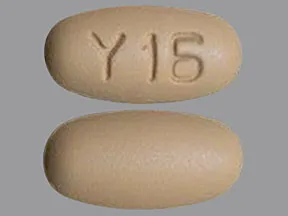 | |
| entacapone oral - | 200 mg tablet |  | |
| entacapone oral - | 200 mg tablet | 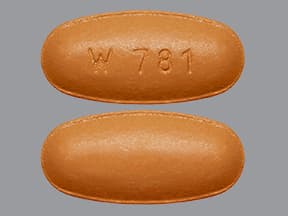 | |
| entacapone oral - | 200 mg tablet | 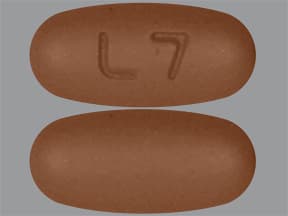 | |
| entacapone oral - | 200 mg tablet | 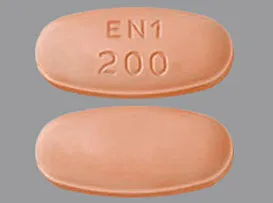 | |
| entacapone oral - | 200 mg tablet | 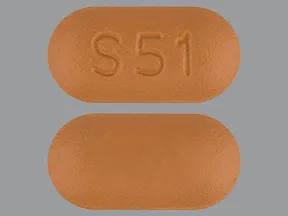 | |
| entacapone oral - | 200 mg tablet | 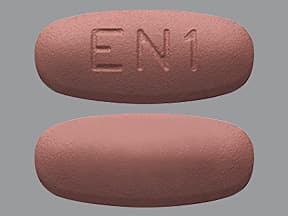 | |
| entacapone oral - | 200 mg tablet | 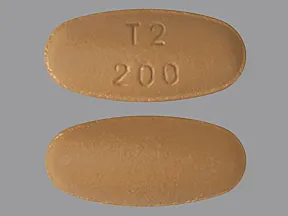 |
Copyright © 2010 First DataBank, Inc.
Patient Handout
entacapone oral
ENTACAPONE - ORAL
(en-TACK-up-own)
COMMON BRAND NAME(S): Comtan
USES: This medication is used with other medications (levodopa/carbidopa) to treat Parkinson's disease. Entacapone belongs to a class of drugs known as COMT inhibitors. Many people taking levodopa for Parkinson's have problems with the effects of the levodopa wearing off between scheduled doses, causing symptoms to return or worsen. Entacapone blocks a certain natural substance (COMT enzyme) that breaks down the levodopa in the body. This effect allows the levodopa to last longer in the system so that it doesn't wear off before the next dose.
HOW TO USE: Take this medication by mouth with or without food as directed by your doctor, usually with each prescribed dose of levodopa/carbidopa (up to 8 times daily).The dosage is based on your medical condition and response to treatment.Use this medication regularly to get the most benefit from it. To help you remember, take it at the same times each day. Do not suddenly stop taking this medication unless instructed to do so by your doctor. Doing so may cause your Parkinson's symptoms to become much worse.Tell your doctor if your condition lasts or gets worse (such as your Parkinson's symptoms are not controlled).
SIDE EFFECTS: Nausea, vomiting, diarrhea, unwanted/uncontrolled movements, increased sweating, drowsiness, tiredness, dry mouth, gas, and abdominal pain may occur. If any of these effects last or get worse, tell your doctor or pharmacist promptly.Lightheadedness or dizziness upon standing may also occur, especially during the first few weeks of treatment. To reduce the risk of dizziness and lightheadedness, get up slowly when rising from a sitting or lying position.Your urine may turn brownish-orange. This effect is harmless.Remember that this medication has been prescribed because your doctor has judged that the benefit to you is greater than the risk of side effects. Many people using this medication do not have serious side effects.Some people taking entacapone have fallen asleep suddenly during their usual daily activities (such as talking on the phone, driving). In some cases, sleep occurred without any feelings of drowsiness beforehand. This sleep effect may occur anytime during treatment with entacapone even if you have used this medication for a long time. If you experience increased sleepiness or fall asleep during the day, do not drive or take part in other possibly dangerous activities until you have discussed this effect with your doctor. Your risk of this sleep effect is increased by using alcohol or other medications that can make you drowsy. See also Precautions section.Tell your doctor right away if you have any serious side effects, including: diarrhea that doesn't stop, mental/mood changes (such as confusion, hallucinations), unusual strong urges (such as increased gambling, increased sexual urges), fever, muscle stiffness, easy bleeding/bruising, sore/painful muscles, muscle weakness, trouble breathing, pain with breathing.A very serious allergic reaction to this drug is rare. However, get medical help right away if you notice any symptoms of a serious allergic reaction, including: rash, itching/swelling (especially of the face/tongue/throat), severe dizziness, trouble breathing.This is not a complete list of possible side effects. If you notice other effects not listed above, contact your doctor or pharmacist.In the US -Call your doctor for medical advice about side effects. You may report side effects to FDA at 1-800-FDA-1088 or at www.fda.gov/medwatch.In Canada - Call your doctor for medical advice about side effects. You may report side effects to Health Canada at 1-866-234-2345.
PRECAUTIONS: Before taking entacapone, tell your doctor or pharmacist if you are allergic to it; or if you have any other allergies. This product may contain inactive ingredients, which can cause allergic reactions or other problems. Talk to your pharmacist for more details.Before using this medication, tell your doctor or pharmacist your medical history, especially of: alcoholism, liver problems, low blood pressure, mental/mood disorders (such as depression, schizophrenia), sleep disorders.This drug may make you dizzy or drowsy. Alcohol or marijuana (cannabis) can make you more dizzy or drowsy. Do not drive, use machinery, or do anything that needs alertness until you can do it safely. Limit alcoholic beverages. Talk to your doctor if you are using marijuana (cannabis). See also Side Effects section.Before having surgery, tell your doctor or dentist about all the products you use (including prescription drugs, nonprescription drugs, and herbal products).Older adults may be more sensitive to the side effects of this drug, especially drowsiness and confusion.During pregnancy, this medication should be used only when clearly needed. Discuss the risks and benefits with your doctor.It is unknown if this drug passes into breast milk. Consult your doctor before breastfeeding.
DRUG INTERACTIONS: Drug interactions may change how your medications work or increase your risk for serious side effects. This document does not contain all possible drug interactions. Keep a list of all the products you use (including prescription/nonprescription drugs and herbal products) and share it with your doctor and pharmacist. Do not start, stop, or change the dosage of any medicines without your doctor's approval.Some of the products that may interact with this drug include: certain MAO inhibitors (isocarboxazid, linezolid, metaxalone, methylene blue, moclobemide, phenelzine, procarbazine, tranylcypromine).Other MAO inhibitors (safinamide, selegiline, rasagiline) may be used cautiously with close monitoring by your doctor. If you are taking rasagiline or selegiline for Parkinson's disease, ask your doctor if you should keep taking it.Entacapone can slow down the removal of other drugs from your body, thereby affecting how they work. These affected drugs include apomorphine, dobutamine, and methyldopa. This is not a complete list.Tell your doctor or pharmacist if you are taking other products that cause drowsiness including alcohol, marijuana (cannabis), antihistamines (such as cetirizine, diphenhydramine), drugs for sleep or anxiety (such as alprazolam, diazepam, zolpidem), muscle relaxants, and opioid pain relievers (such as codeine).Check the labels on all your medicines (such as allergy or cough-and-cold products) because they may contain ingredients that cause drowsiness. Ask your pharmacist about using those products safely.
OVERDOSE: If someone has overdosed and has serious symptoms such as passing out or trouble breathing, call 911. Otherwise, call a poison control center right away. US residents can call 1-800-222-1222. Canada residents can call 1-844-764-7669. Symptoms of overdose may include severe drowsiness, coma, confusion, agitation.
NOTES: Do not share this medication with others.Lab and/or medical tests (such as liver function) should be done while you are taking this medication. Keep all medical and lab appointments. Consult your doctor for more details.
MISSED DOSE: If you miss a dose, take it as soon as you remember. If it is near the time of the next dose, skip the missed dose. Take your next dose at the regular time. Do not double the dose to catch up.
STORAGE: Store at room temperature away from light and moisture. Do not store in the bathroom. Keep all medications away from children and pets.Do not flush medications down the toilet or pour them into a drain unless instructed to do so. Properly discard this product when it is expired or no longer needed. Consult your pharmacist or local waste disposal company.
Information last revised May 2024. Copyright(c) 2024 First Databank, Inc.
IMPORTANT: HOW TO USE THIS INFORMATION: This is a summary and does NOT have all possible information about this product. This information does not assure that this product is safe, effective, or appropriate for you. This information is not individual medical advice and does not substitute for the advice of your health care professional. Always ask your health care professional for complete information about this product and your specific health needs.
Formulary
Adding plans allows you to compare formulary status to other drugs in the same class.
To view formulary information first create a list of plans. Your list will be saved and can be edited at any time.
Adding plans allows you to:
- View the formulary and any restrictions for each plan.
- Manage and view all your plans together – even plans in different states.
- Compare formulary status to other drugs in the same class.
- Access your plan list on any device – mobile or desktop.







